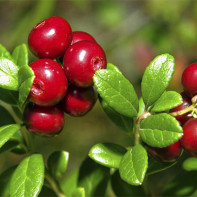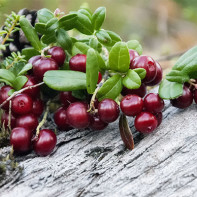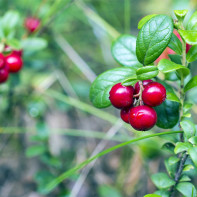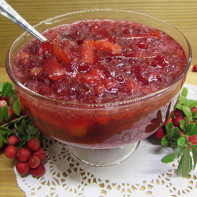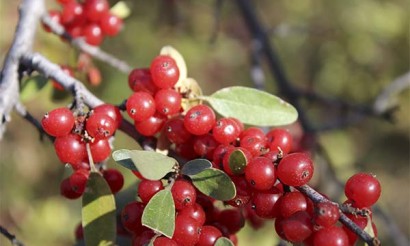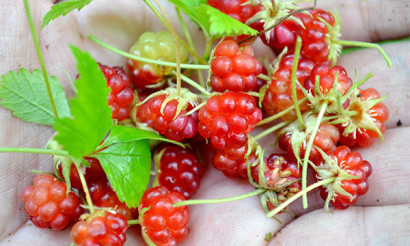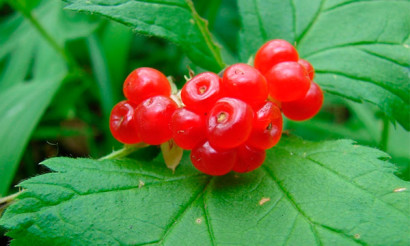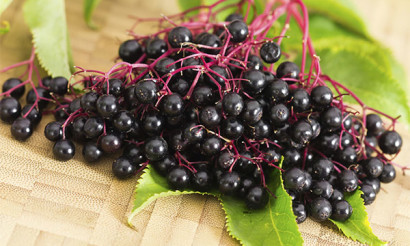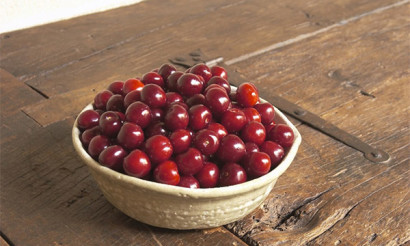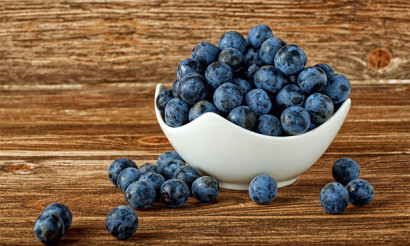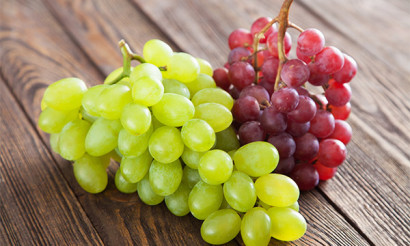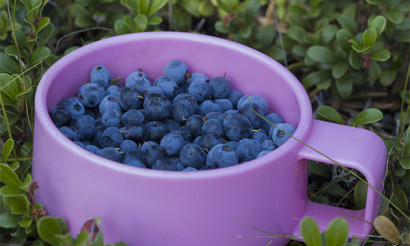Lingonberry: useful properties and contraindications
Those who are interested in this berry, definitely need to know how it looks and how it differs from others. The fact is that it can easily be confused, for example, with wolfberries or cranberries. Residents of Siberia or areas of the tundra know almost everything about it: where it grows, what it is, etc.
- Where it grows and how it looks like a lingonberry
- When to pick
- What is the difference between cowberries and cranberries
- Which is more useful: cranberries or cowberries
- How to distinguish cranberry from bearberry
- Composition and calories
- Useful properties of cowberries
- For Women
- For Men
- In Pregnancy
- Breastfeeding
- For children
- Slimming
- The Dried Lingonberry Benefits
- Lingonberry Leaf Medicinal Properties
- Lingonberry in medicine
- For Diabetes Mellitus
- For pancreatitis
- For gastritis
- For the bowel
- For constipation
- For gout
- For hemorrhoids
- For cholecystitis
- Cystitis
- With a cold
- Recipes of folk medicine based on cowberries
- With acute respiratory infections
- Infusion with inflammation of the kidneys or bladder
- With enuresis
- Cystitis Treatment
- When constipation
- Lingonberry in cosmetology
- For Face
- For Hair
- Harm and Contraindications
- How to Properly Store Lingonberry
- Can be frozen
- How to eat red whortleberries
- How much you can eat per day
- Is it allowed to eat at night?
- What can be cooked from cowberries: Recipes
- Mors
- Compote
- Jam
- Lingonberry juice
- Tea with cowberries
- Sauce with meat
- Can I Give Lingonberry to Animals
- Interesting facts about lingonberries
Where does the cowberry grow and what does it look like?
Lingonberry is a plant that is a low bush, reaching a height of about 20-25 cm. It is noteworthy that the age of the plant is determined not by the stems, as with most, but by the root. The root system of lingonberry is very developed. So, one bush can occupy an area of about 10 square meters. The average life span of the stems themselves is usually 3-5 years, and over time they are replaced by new ones.
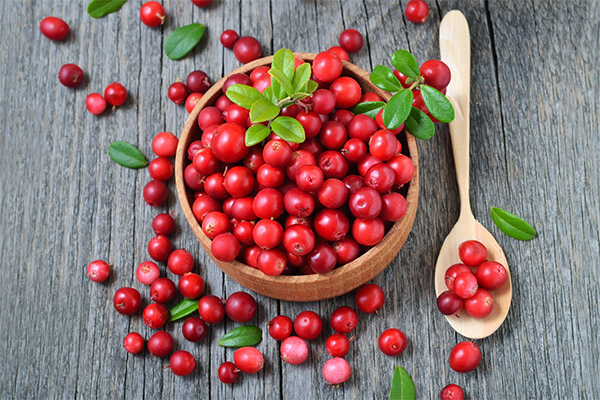
Lingonberry grows in colonies, in which one plant can live for more than 2 centuries. If the shrub "lives" on its own, the lifespan is limited to only 10 years.
The leaves of the plant are dark green in color, hard to the touch, perfectly tolerate frosts. Blossoms in early summer with small white flowers, shaped like a bell, which are almost odorless. Fruits are bright red in color, of regular round shape, which can reach a diameter of 6-8 mm, the surface is shiny.
Lingonberry bushes can be found in dry mixed coniferous forests, in peat bogs, sometimes on bolts located in wooded areas in the northern part of the Russian Federation.
When to pick
The fruits of cranberries ripen at the very beginning of autumn. Initially they are green in color, then they become white, and the mature ones turn a beautiful red color. They may be picked before the first frosts. After that, the berries lose their flavor, become soft and unsuitable for picking. Some sausage-pickers say that cowberries may still be picked after the first snow, but this is an individual case rather than a rule.
By the way, lingonberries can be picked still unripe and then put next to tomatoes. The gas emitted by the latter during storage will make the lingonberries redden and ripen.
Despite the fact that the fruits become ripe as early as September, it is recommended to pick them in October.
What is the difference between cranberries and cranberries
Cranberries and cranberries are very similar in appearance and composition, but there is a difference, if you constantly collect these berries, over time you can quickly distinguish one from the other:
- The berries of the plants differ in taste, namely, cranberries are sour, while lingonberries are sour-sweet. The fruits of the former are dark red, with a slight pressure immediately secrete juice. Cranberries are bright red in color and more dense. They are also different in size. Lingonberry is somewhat smaller than cranberry; its fruits are rarely more than 6 mm in diameter, whereas the berries of the second plant are at least 1 cm.
- Also cranberries and lingonberries differ in the shape of their leaves. The first has an ovoid shape, while the second has larger and elliptical leaves.
- Among other things, the plants grow in completely different places. For example, cranberries prefer exceptionally wet places, they can be found in swamps, along the banks of a river or lake. Cranberries, on the contrary, prefer dry places on a slight elevation.
Which is more useful: cranberry or cowberry
As it was mentioned above, cranberry also differs from cranberry in composition, first of all it has twice as much calories. It contains by an order of magnitude more of all vitamins, micro- and macro-elements. Based on this, we can draw a fairly simple conclusion that cranberries are much healthier. But despite this gap, both berries are considered a treasure trove of vitamins and elements.
How to distinguish cranberries from bearberries
When picking cranberries, it is important to know how they differ from bearberry. The fact is that the plant is very similar in the size of the bush, berries and leaves. Berries of the second are not consumed in food and can cause severe poisoning, but its leaves are medicinal and used to cure many ailments.
So, the plants are very similar and even grow together sometimes. However, it is quite easy to distinguish them.
- Firstly, you need to look closely at the leaves themselves, the cranberry has an oval, elliptical shape, while the bearberry has ears like a bear's.
- Secondly, bearberryberry branches are almost flat on the ground and if you put two bushes next to each other the difference is immediately apparent.
- And lastly, there are many small pips in cowberry berries, while bearberry berries have few and large pips. In addition, the taste of bearberry fruits is unpalatable.
Important! If you eat a few berries of bearberry, then nothing bad will happen. But if you eat a lot of it, you can get very serious poisoning, which is accompanied by gastrointestinal disorders, vomiting, dizziness, chills, etc.
Composition and calories
Lingonberry is a wild berry, which has been collected since time immemorial, its fruits are known for their medicinal properties, as well as the leaves. Cranberries were first attempted to be cultivated in the 18th century by order of Elizabeth Petrovna, the tsarina, who wanted them to be grown near the Russian capital. However, the first successful attempts were not made until the last century.
Cranberry fruits contain a truly unique complex of vitamins and minerals, as well as benzoic acid.
The energetic value of the fruit is only about 40 kcal per 100 grams, so you can not worry about the figure:
- Proteins - less than 1 g.
- Fats - less than 1 gr.
- Carbohydrates - about 10 gr.
Vitamins
Vitamin A was discovered by scientists first, hence its name. It is also called retinol. It is involved in virtually all processes in the body:
- Necessary for metabolism and the synthesis of some important proteins.
- Prevents free radicals from affecting the body.
- Increases the body's defenses.
- Participates in the formation of bone tissue.
- Necessary for the formation and growth of cells.
- It ensures the normal functioning of the retina.
Vitamin C is probably the most important and necessary vitamin. The human body is not able to synthesize it, and therefore it is necessary to consume foods that contain it. It has a positive effect on the nervous system, strengthens blood vessels and regulates blood circulation. It removes toxins from the body, regenerates tissue cells and promotes the absorption of iron. Increases protective functions and stimulates immunity.
Lingonberry also contains vitamin E, PP and K.
Micro- and macronutrients
- Iron. An important element that is necessary for the formation of hemoglobin, which means it is directly involved in hematopoiesis. Lack of iron causes drowsiness, dizziness, muscle pain, and with greater deficiency - can develop acute anemia and anemia.
- Calcium. First of all, it is a building material for bone tissue and tooth growth. Calcium is also responsible for blood clotting, muscle contraction, and strengthens the walls of blood vessels.
- Potassium. The third most important element, it is an electrolyte and serves to conduct impulses in the nervous system. It also regulates the water balance. Potassium is an energy element, necessary for muscle and heart function. If it is deficient, acute muscle pain, spasms and even paralysis can occur.
- Magnesium. Necessary for digestion of B vitamins and calcium, it is involved in energy production, blood clotting, reduces nervous system response to external stimuli, and is necessary for the formation and growth of new cells.
- Chromium. This element activates enzymes that participate in the synthesis of carbohydrates, thereby regulating blood sugar levels. Sufficient chromium reduces the risk of obesity and diabetes. It reduces the amount of harmful cholesterol, and its reserves help the body to tolerate stressful situations with minimal consequences.
Lingonberry contains benzoic acid, which is used for preserving food. It can neutralize germs and bacteria and keep the berry fresh for a long period of time.
Useful properties of cowberries
For Women
Any woman must love this berry for its high content of vitamins A and E, which are also called "rejuvenating vitamins". For example, vitamin A promotes rapid regeneration and growth of dermis cells, which makes the skin beautiful and youthful. It also produces collagen, the amount of which decreases significantly in the body after 30 years. It is also important to note that vitamin A is a natural antioxidant, which levels the impact of free radicals on the body, thereby significantly slowing the aging of skin cells, hair and nails.
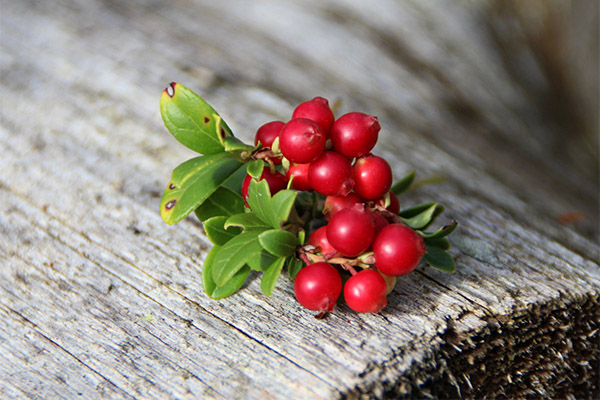
Vitamin E for the female body is difficult to overestimate, as it is involved in many processes. Its importance is so great that it is even produced as a separate drug in the form of various supplements.
In addition to the fact that vitamin E actively protects all cells from aging, it helps strengthen the hair along its entire length, with its sufficient amount of ends will never start to split. It has a similar effect on the nails.
Vitamin E regulates the production of hormones in the body, and for women over 45 years eases menopause. It also improves vision, hearing and memory.
For men
Lingonberry also has a specific effect on the male body. Few people know, but it is part of most medicines for prostatitis. The berry is a diuretic, while at the same time it disinfects the ducts of the genitourinary system. With regular use in its fresh form, male strength will be preserved for many years.
Do not forget about potassium, which is necessary to maintain the cardiovascular system. Its sufficient amount will prevent many diseases, including reducing the risk of heart attack.
Calcium is essential for an active lifestyle and great physical activity, and vitamin E will strengthen blood vessels, improve memory and vision.
Pregnancy
For centuries, only cranberries have been used to treat diseases during pregnancy, it is believed that it is hypoallergenic. But before starting a course of treatment or using the recipes of folk medicine, it is necessary to get a consultation with a doctor.
Consuming lingonberries during pregnancy, the future mother saturates her body with all the necessary vitamins and minerals. The berry strengthens the skeleton of the unborn child and helps to reduce swelling of the pregnant woman's legs, as well as the amount of excess fluid in the body. The berry prevents the occurrence of anemia in both the expectant mother and the baby.
Lingonberry is an antipyretic, which is safe for the fetus. A complex of vitamins and minerals in the berry is able to neutralize the negative impact on the body of all kinds of viruses and bacteria.
When breastfeeding
In the case of cranberries, traditional medicine is completely on the side of folk medicine. Due to the presence of many vitamins and minerals, the berry is very useful when breastfeeding, because everything that affects the mother's body directly affects the child.
Despite the fact that lingonberry is a fairly safe product, it is not recommended to introduce it in the first month after birth, because the baby's stomach is just beginning to get used to the new products.
Lingonberry provides excellent protection for mother and child, strengthens tissues, promotes normal development and growth of the body.
For kids
Lingonberry can be introduced to the child's diet from a fairly early age, in the form of morsels. You should not give it to children only if there are kidney disease and poor blood clotting, in which case it will do more harm than good.
In addition to vitamins and minerals, berry contains phytoncides that successfully cope with viruses on a par with antibiotics. Therefore, lingonberries will be an excellent remedy for various diseases in children.
Useful properties for children:
- Due to the special properties of the berry, it regulates metabolism and brings it to normal.
- Lingonberry is an excellent diuretic, which, unlike drugs, has no side effects.
- The berry has the ability to remove heavy metal salts and toxins from children's bodies.
Of course, children rarely have high blood pressure, but intracranial pressure is quite common, and there is no better remedy for it than lingonberry for a child.
When losing weight
For those who follow a diet and want to get rid of extra pounds, lingonberry will be an indispensable product. It contains a minimum amount of calories and sugar. That is why it is included in most diets.
In addition, the leaves contain tannin, which regulates the metabolism, namely, the absorption of carbohydrates, thereby burning just a huge amount of fat in the body.
Please note! If there are problems with the liver, it is not recommended to use cranberries for weight loss.
Dried cowberries are useful
Dried cranberries are as useful as fresh berries. Its uniqueness is that not only the berries, but also the leaves are useful. This is why not only the fruits but also the leaves of the bushes are harvested during harvesting.
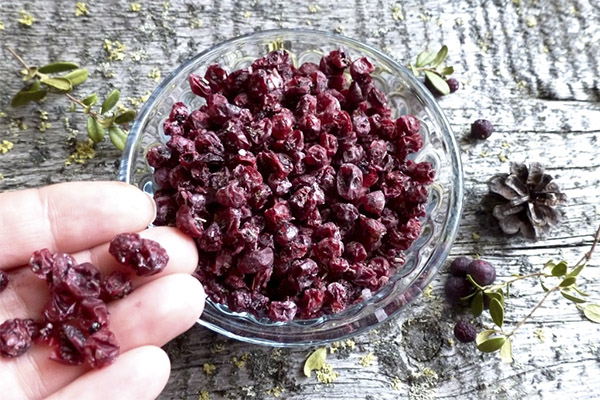
Dried berries are harvested as a whole or chopped. In the second case, you get a delicious marshmallow, which can be stored for a long time. Moreover, its recipe is very simple. From dried berries, tea, decoctions and compotes are prepared.
Benefits:
- Supports the cardiovascular system at a proper level.
- Removes toxins and impurities from the body.
- Decoction of dried cranberries - an excellent and safe diuretic.
- Tannins in the composition of the berry help the body to get rid of toxins and heavy metals.
- Improves digestion and peristalsis of the gastrointestinal tract.
- Drinks made from dried cranberries are an excellent thirst quencher.
Therapeutic properties of lingonberry leaves
Along with the collection of berries, it is mandatory to harvest the leaves of lingonberries, which have almost the same properties as the fruits. They contain tannins, arbutin, tannin, hyperoside, etc.
The therapeutic properties of lingonberry leaves have been known since ancient times, even modern science has recognized that they are very useful in the treatment of certain diseases. They are mainly used to prepare teas and decoctions, which are used for inflammatory problems and metabolic disorders in the body.
Lingonberry leaves regulate metabolic processes in the body, remove toxins, heavy metal salts and crush kidney and gallbladder stones.
Other useful properties of lingonberry leaves:
- normalize blood pressure;
- Help in diseases of the genitourinary system;
- heal the joints;
- Decoction of lingonberry leaves is shown in diseases of the oral cavity.
Lingonberry in medicine
For diabetes
Diabetes mellitus occurs more and more often, the WHO classifies it as one of the most common diseases on the planet. Many medicines are being developed for treatment, and they are becoming more effective every day. As for folk medicine, there are no recipes or herbs that can cure diabetes mellitus. To successfully fight the disease, it is important to follow a diet. So, many products are excluded from the diet, even some fruits and berries, however, this does not apply to lingonberry, on the contrary - it plays an important role in the diet of diabetic patients.
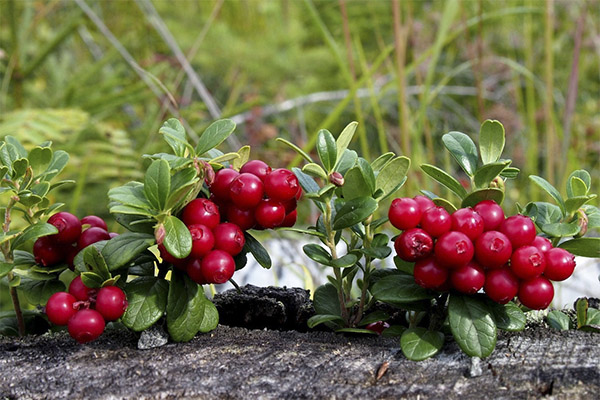
Lingonberries are a storehouse of vitamins and useful macro- and micronutrients, which is important when restricting food. Diabetic berries are a catalyst for the action of insulin. This means that some substances are absorbed by the body better - it does not expend extra insulin.
Pay attention! Experts advise consuming at least two glasses of cranberries a day during the berry picking season, dividing them into several meals.
In diabetes, you can also use lingonberry leaves, decoction from them perfectly copes with diseases of the genitourinary system, without the use of antibiotics. Often diabetic patients have high blood pressure, in which case a decoction of lingonberry leaves will be very helpful.
Also, the leaves of the plant contain substances that help control blood sugar.
Important: The glycemic index of cranberry is 25 units.
Pancreatitis
Pancreatitis is a severe disease in which the pancreatic enzymes released do not get into the duodenum, but begin to act directly in it, causing its destruction. About half the cases of disease are associated with excessive consumption of alcohol. In addition to treatment, it is necessary to strictly adhere to a diet.
The course of the disease is characterized by two stages: acute and remission. In the first case, fresh berries must be abandoned, because they contain acids and substances that stimulate the active release of pancreatic enzymes. However, cranberries can be included in the diet after heat treatment. This can be kissels or a weak decoction. During remission, the list of products in the diet expands considerably, you can already use juices, morses and other drinks. Fresh berries should be treated with caution; they can be included only after consulting your doctor.
Regular use of products based on cranberries, during the illness can significantly improve health:
- Kisses, decoctions and juices quench thirst, relieve pancreatic inflammation.
- Restore damaged tissues and cells.
- Promote a speedy recovery.
Gastritis
Gastritis is a disease characterized by inflammation of the mucous membrane of the stomach. For successful treatment, as with diabetes and pancreatitis, a certain diet should be followed, although not as strict. It is strictly forbidden to consume lingonberries, if the disease occurs against a background of increased acidity, but if not, then a moderate amount of berries will contribute to a speedy recovery. With gastritis you can consume not only berries, but also diluted fresh juice, decoctions, teas.
For the intestines
Benefits for the gastrointestinal tract from lingonberry were noticed long ago. For example, capricious children were given some berries before dinner, and they ate everything served to the table. Now it is known for sure that due to the presence of many organic acids, cranberries stimulate the appetite and contribute to the abundant secretion of saliva. In addition, it activates the production of enzymes and gastric juice, which affects the speed and ease of digestion processes, as well as the digestibility of nutrients and vitamins by the body.
There is also pectin in the rind of berries, which greatly improves the peristalsis of the stomach. It also "cleanses" the body of toxins and other harmful substances.
For constipation
As mentioned earlier, lingonberry has a positive effect on the gastrointestinal tract and is a good diuretic, but many people forget that if they regularly eat it, there will never be constipation. The fact is that with normal peristalsis of the stomach, the occurrence of constipation is impossible. Also, lingonberry promotes the formation of liquid, which softens the stool and facilitates its exit. And the ability to neutralize the toxins that occur during constipation makes it one of the best remedies in the fight against them.
If you have a problem with stool, drinking a solution made with cranberries, it can be solved literally in one day. In severe cases, the treatment may take a longer time.
In gout
The disease is caused by the deposition of salts of uric acid in the joints, which is a consequence of an imbalance in the body's metabolism of such substance as purine. For treatment, you should avoid foods with a high content of this substance.
In folk medicine, there are several recipes using lingonberry to treat the disease. The benefit is that it relieves inflammation, restores bone and cartilage tissue, and gently and painlessly removes uric acid salts from the body.
It is impossible to cure gout with lingonberry alone, but to improve the effect of medication, many experts prescribe taking it in the form of fresh berries and decoctions from the leaves.
Hemorrhoids
Hemorrhoids are a disease in which the blood circulation in the pelvis is disturbed. It can be caused by improper diet, excessive use of fatty foods, gastrointestinal disturbances and sedentary lifestyle.
First of all, with this disease it is important to normalize the stomach and stool. In this regard, cranberries will be very helpful. This can be both fresh berries and teas, as well as decoctions and infusions from the leaves.
The berry normalizes the gastrointestinal tract, blood circulation, relieves inflammation and gets rid of constipation, which is necessary in order to overcome the disease.
In cholecystitis.
Inflammation of the gallbladder occurs due to urolithiasis. This leads to damage to the gallbladder mucosa, so lingonberry should not be used for treatment - a large amount of organic acids can cause exacerbation.
In cystitis
It should be noted that the components contained in the berries and leaves of cowberries are part of almost all medicines that are prescribed for the treatment of cystitis. As soon as manifestations of the disease begin, you can, without waiting for diagnosis, use lingonberries and remedies from them for prevention. The berry relieves inflammation of the bladder, relieves pain when urinating, destroys the bacteria that cause the disease, and disinfects the ducts.
The effect of using fresh berries in the treatment of cystitis will be much lower than from infusions and decoctions of it or leaves.
With colds
Lingonberry is an excellent remedy for fighting colds, often doctors advise to use it for severe chills and fevers, it enhances the effect of antibiotics, and its components in its composition fight viruses and infections. Mors, decoction or tea is an excellent remedy for colds, SARS or flu, as it perfectly quenches thirst, relieves fever, actively fights infection and gives vitality.
Lingonberry activates the protective properties of the body and thus contributes to a speedy recovery. It is recommended to use it not only to fight diseases, but also for their prevention.
Lingonberry-based folk medicine recipes
Since lingonberry has strong antibacterial properties, it is probably best to start with a recipe that will help cope with any cold.
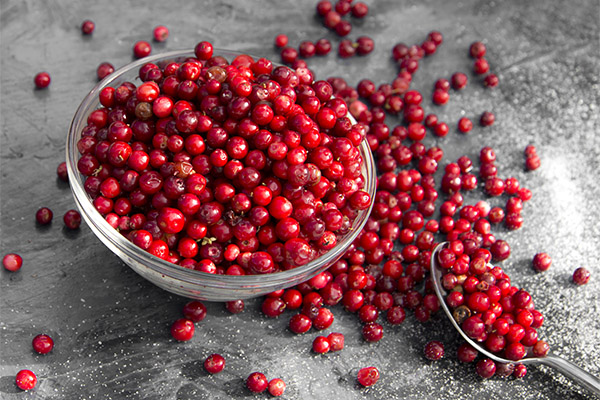
With acute respiratory infections.
For preparation you will need:
- dried berries and leaves of lingonberries;
- honey and water.
How to prepare:
- Berries (20-30 g) and leaves (250-300 g) thoroughly rinse with water and put in a bowl where the broth will be prepared.
- Separately need to boil water - 0.5 liters.
- Pour boiling water over the leaves and berries and put to boil for another 15-20 minutes.
- Then remove from the heat, cover and leave for half an hour.
- Add honey.
Decoction should be drunk 3-4 times a day, adults - 200-300 ml, children cut the dose in half.
Infusion with inflammation of the kidneys or bladder
This recipe is very simple, but at the same time quite effective. To prepare it, you will need 20 grams of cowberry leaves and a glass of water.
Prepare the infusion is simple: put the leaves in a thermos and pour boiling water, insist at least 1 hour.
The infusion should be consumed by tbsp. spoon 2-3 times a day before meals, it must necessarily be warm, so it must be heated each time.
With enuresis
Involuntary emission of urine occurs after falling asleep, after 2-3 hours. The causes can be different: problems of the genitourinary system, stress, etc. Most often the phenomenon occurs in children, you can cope with it with folk remedies, in particular with the help of decoction from lingonberry leaves.
For preparation you will need:
- Lingonberry leaves and berries 1 tbsp. each;
- St. John's wort - 2-3 tbsp. spoons;
- water - 600-700 ml.
How to cook:
- Wash the ingredients, mix, add water and put on the fire.
- Bring to a boil, simmer for 10-15 minutes over low heat.
- Decoction strain.
The decoction is taken three times a day, one glass, to start after 17:00, the last hour before bedtime.
Treatment of cystitis
In the treatment of cystitis, experts recommend drinking plenty of fluids, because this way the bladder is cleared of bacteria that caused the disease. You can use compote, tea or lingonberry infusions for treatment.
Recipe for compote
To prepare the compote is very simple, for this 3-4 cups of fresh berries are thoroughly washed. Then pour water, put on the fire and bring to a boil. Long heat treatment with fresh berries is better not to do, so loses vitamin C. Therefore, immediately after boiling the container with the berries should be removed from the stove and allow the compote to infuse. For treatment, you should drink as much of this drink as possible. To improve the taste, you can add sugar or honey.
With constipation
Everyone suffers from constipation - both adults and children. Lingonberry is the best remedy to cope with this problem quickly and effectively.
For preparation you will need:
- fresh lingonberry juice - 50 ml;
- boiled water - 200 ml;
- tbsp. honey.
Juice, water and honey mix, everything - the remedy is ready.
Adults need to take the mixture at least 4 times a day for 100 ml. Children 50, with the same frequency. Even the most complicated case will resolve no later than 3 days of using this medicine. If the problem is not resolved after the course, then you should immediately consult a doctor.
Lingonberry in cosmetology
Vitamin A and E are included in most face and hair care products, thanks to them the skin becomes elastic, firm, small wrinkles are smoothed, and deep wrinkles become less noticeable. Hair becomes shiny and strong.
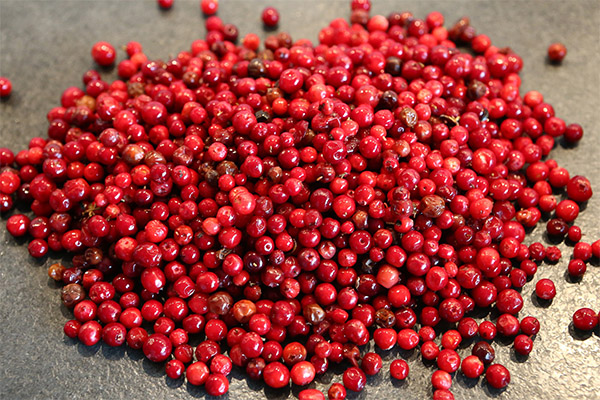
For the face
Before preparing a face mask or tonic from cranberries, you need to make sure that its juice will not cause an allergic reaction, and to do this you need to test by putting a drop of juice on the wrist.
Lotion from acne
To prepare such a lotion, you will need to mix a glass of freshly squeezed juice from cranberries with mineral water, which contains a lot of salts. The juice can even be squeezed from frozen berries. Face should be wiped with this lotion after washing in the morning and at night. After a while, acne will disappear, acne will decrease, and black spots can be forgotten forever.
Recipe for a mask for fading skin
What you will need:
- half a cup of lingonberries (you can use frozen);
- One white of a hen's egg.
How to prepare:
- The berries should be thoroughly crushed and add the white of the egg.
- Thoroughly mix everything.
Apply the mixture to your face and leave it for at least 25 minutes. Then rinse with warm water and apply moisturizing cream. After the first application the natural complexion will return, wrinkles will become less pronounced and dark spots will disappear.
Scrub
What you will need:
- The shells of 3 walnuts;
- Cranberries - 2 tsp.
How to cook
Crush the shells, grind in a blender or meat grinder, add the pounded berries. To enhance the effect you can add half a tsp. of olive oil.
Rub into the skin in a circular motion, leave it to work for no more than 25 minutes. Then rinse with warm water and apply moisturizing cream. Scrub is suitable for all skin types.
For Hair
Mask that prevents hair loss
To prepare this mask, you will need lingonberry juice, carrots, castor oil.
- Carrots (1 pc) are washed, peeled, grated.
- Add lingonberry juice 1/3 cup and oil 1-2 tbsp.
The resulting mixture is applied to the roots of the hair, cover with a rubber cap or film, wrap with a terry towel and leave to act for 1-2 hours. Then rinse with water and shampoo. Hair becomes strong, soft and fluffy.
Mask to restore the structure of hair
What will be needed:
- vegetable oil - 2 tbsp;
- lingonberry juice - 2 tablespoons;
- The yolk of two eggs;
- 1 drop of lemon oil.
How to cook
Mix the juice and vegetable oil. Then add the yolks and lemon oil. Thoroughly mix with a mixer.
Apply the mask evenly on the entire length of the hair and leave to act for half an hour. Then wash off with warm water and shampoo. You can use it no more than 3 times a month, if the condition of your hair is too bad, you can increase the amount to 4.
Hair rinse
Lingonberry leaves are used mainly for the treatment of the skin. If itching and dandruff appeared, you can prepare a rinse from them.
To do this, you need to prepare a decoction of 1 tbsp. spoonfuls of crushed cranberry leaves and 1 cup of water. The rinse can be used regularly until the symptoms go away.
Harms and contraindications
Despite the fact that lingonberry has many beneficial minerals and vitamins, it can cause harm to the body. It has strong therapeutic properties, so introduce it to the diet carefully and gradually. If after using it you won't feel worse, you can continue eating it, if not, then it should be removed from your diet.
It is not recommended to use lingonberry in case of increased stomach acidity. People with low blood pressure should be very careful with it, because it significantly lowers the blood pressure. Never use cowberries for cholelithiasis.
Also do not forget about the individual intolerance of berries.
How to store cowberries
Due to the presence of benzoic acid in cranberries, its berries can be stored for quite a long time without treatment.
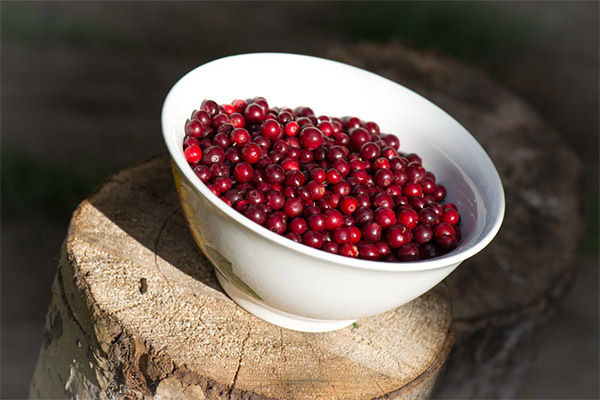
Storage methods:
- In water. To do this, choose ripe, not overripe berries, wash, put in a jar and leave for 2-3 days. Then drain the water and get fresh, cover tightly. So berries can be stored for up to 2 months and stay fresh.
- In the fridge. To do this, you need to sort through the berries, remove the spoiled and despicable. Wash and dry, then put them in a deep container and put them in the refrigerator. Lingonberries will retain their freshness and taste for up to 3 months.
Also lingonberries can be soaked, dried and made into jam.
Can they be frozen?
Today you can find frozen vegetables on sale in all supermarkets. Most of them can not be frozen at home, because a special technology - "blast freezing" - is required. However, this does not apply to cranberries. Frozen lingonberries fully retain all the vitamins, and the family can enjoy them all year round.
In order to freeze it, you must first sort the berries: remove spoiled and overripe. Thoroughly rinse, dry, remove twigs. Pack hermetically in bags and put in the freezer.
How to eat lingonberry
How much you can have per day.
The amount of cranberries eaten directly depends on the individual characteristics of the body, but there are general recommendations. So, according to them, you should not consume more than 170-210 grams of berries per day. This is due to the content of saccharides. From them, of course, you will not gain weight, but they can give a serious load on some organs, and if you take into account that for sure the cranberries will be eaten with something sweet, then this load will be doubled.
Is it possible to eat at night
If we consider that the berries are not caloric, have the ability to regulate blood pressure, then we can conclude that they can and should be eaten before bedtime.
What can be cooked from cranberries: recipes
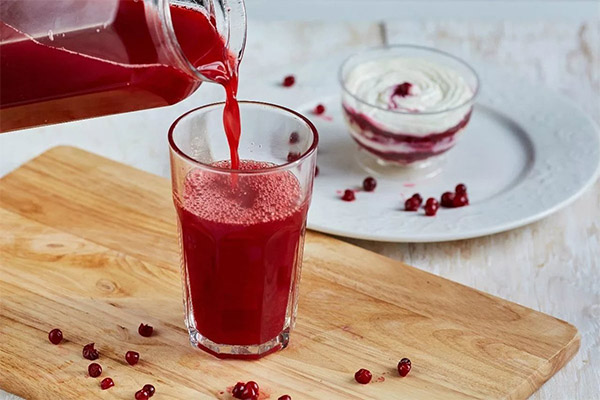
Morses
What will be needed:
- Lingonberries - 250-300 g;
- water - 1 l;
- sugar to taste.
How to cook
The berries should be crushed so that they let the juice flow. Pour the water. Add sugar and mix everything very carefully. Then you can put them on a fire, bring them to the boil.
Once the water boils, remove the morsel and let it cool. Serve cool.
Compote
What you will need:
- 0.5 kg of cranberries;
- 1.5 liters of water;
- honey, sugar to taste;
- lemon - 1 pc;
- 1 cinnamon stick, cloves.
How to cook:
- Fill cranberries with water and put them on the fire. Once the water boils, the composition of boiling for 15-25 minutes over low heat.
- At this time, squeeze the juice of a lemon.
- Then the juice, spices, sugar and honey are added to the cranberries and everything is stirred until the sugar dissolves.
- Give the compote to infuse for half an hour.
- You can use it both hot and cold.
Jam
For cooking you will need:
- cranberries;
- sugar sand.
How to cook:
- Berries are carefully washed, remove leaves and twigs.
- Put them in a saucepan and add water, bring to a boil.
- Then bring the sugar, its number equal to about half the weight of berries, mix thoroughly and boil for 20 minutes.
- The jam is poured into jars and corked.
Lingonberry juice
This recipe for making juice for the winter distinguishes a long cooking time, but the result is worth it.
What will be needed:
- lingonberries;
- sugar.
How to cook:
- Only very ripe berries are suitable for cooking, which are sorted out and washed.
- Pour water, so that it just covered the fruit, and put on the stove. Bring to a boil.
- Then immediately remove and let stand for half an hour.
- Then the berries are carefully placed in a colander and left overnight.
- The juice obtained the next day should be weighed.
- Add sugar - its amount is half the weight of the juice.
- Place on the fire. Once the juice boils, boil for 10 minutes.
- After that, you can drink it chilled or bottle it for the winter.
Tea with lingonberries
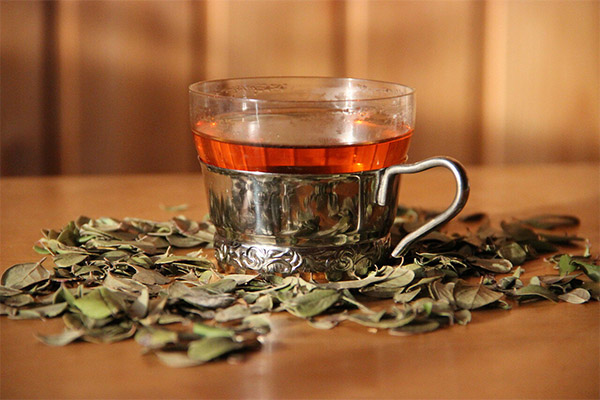
When making tea, you can add a few lingonberries to it, either dried, fresh or frozen. The quantity depends on personal preference.
Sauce with meat
To make the sauce you will need:
- very ripe lingonberries - 0.5 kg;
- starch;
- white wine - 100 gr;
- cinnamon.
How to cook:
- Lingonberries are thoroughly washed and remove the leaves and twigs.
- Pour water of about 1/4 liter and put on the fire.
- Boil until the berries begin to burst.
- Then you need to take them out, cool and rub them through a sieve.
- The resulting mass is added to the same water and put back on the fire.
- Once the water comes to a boil, add the sugar (0.5 cup) and a pinch of cinnamon.
- Cook over low heat until the mixture has reduced by 1/3 of its original volume, then add the wine.
The sauce can be served cold or hot.
Can we give lingonberries to animals?
Many animals in the natural environment eat cowberries: bears, wolves, foxes, hares, as well as birds. Therefore, it is possible to give lingonberries to pets. In this case, you only need to check whether the pet has an individual intolerance. At the same time, it is rare that any dog or cat will consume lingonberries.
Interesting facts about cowberries
- Lingonberry blooms for a short time - only 14 days.
- It is called the "queen of berries".
- The plant grows normally even in very harsh conditions, for example, in the tundra or mountains.
- In traditional medicine, it is used to prepare infusions and decoctions.
- Lingonberries are used to treat tuberculosis.
«Important: All information on this site is provided for informational purposes only. for informational purposes only. Consult a specialist before using any recommendations. specialist. Neither the editors nor the authors shall be liable for any possible harm caused by materials."

